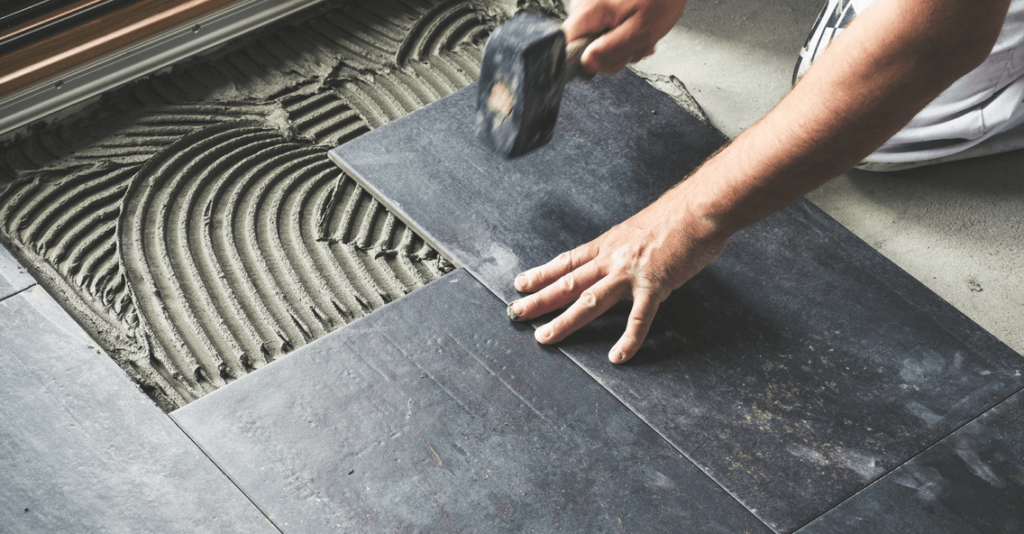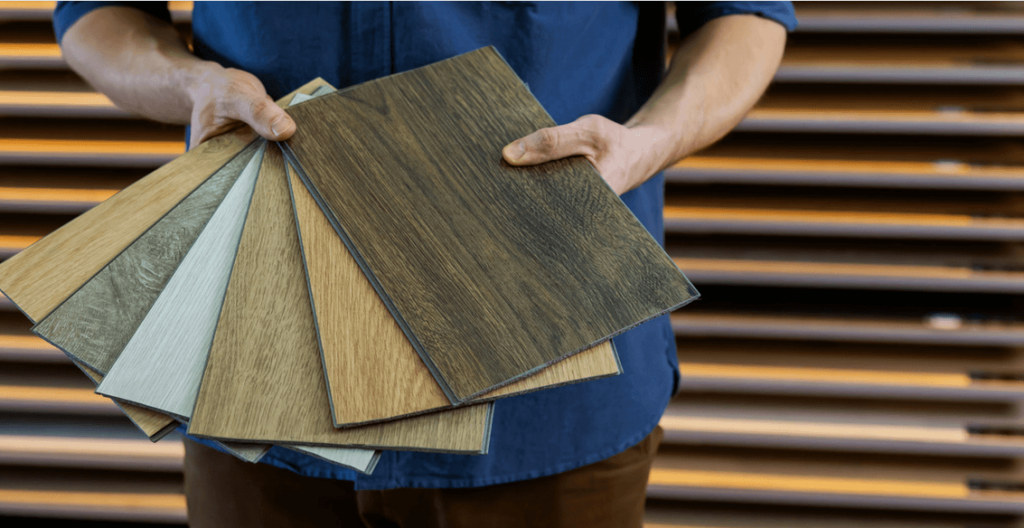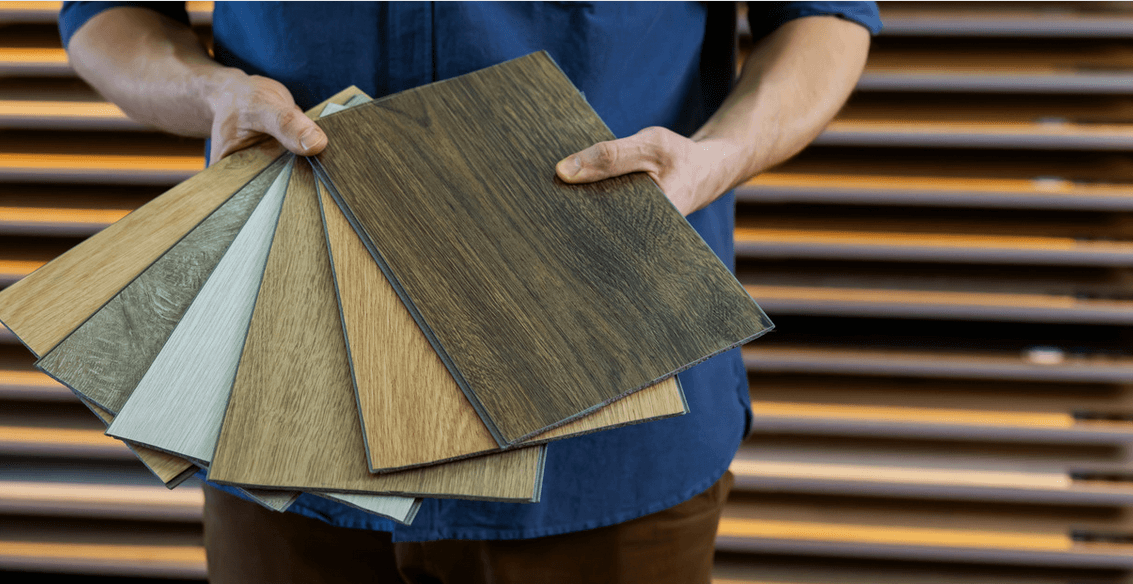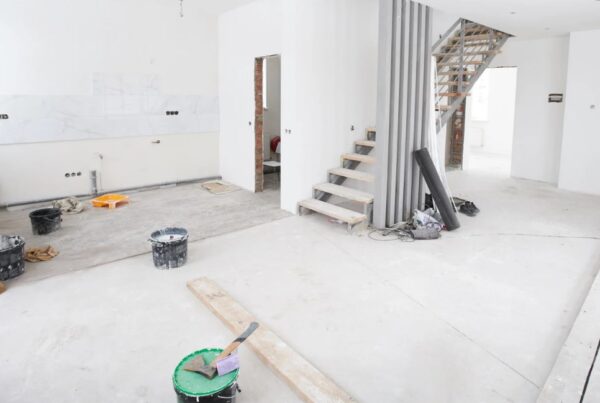How to choose the perfect flooring for your home
In this guide, we’ll explore how to choose the perfect flooring for your home and provide you with insight needed to enhance the beauty and functionality of your home for years to come.
Choosing the right flooring for your home is a decision that goes beyond mere aesthetics. It’s a choice that affects your living spaces’ functionality, comfort, and overall feel. Flooring is a crucial element that can transform the look and feel of your home, providing a foundation for your decor and enhancing the quality of life for you and your family. With many flooring options available today—from the warm and inviting feel of hardwood floors to the cool elegance of tile, the comfort of carpet, and the practicality of laminate and vinyl—it can be overwhelming to decide. Each type of flooring offers distinct advantages and sets a different mood and ambiance for a room. In addition to style and personal preference, factors such as durability, maintenance, and budget also play crucial roles in selecting the perfect flooring that aligns with your lifestyle and the aesthetic of your home.
Assessing Your Needs and Lifestyle
Understanding Traffic and Wear
When considering how to choose the perfect flooring for your home, it’s essential to consider the daily foot traffic in various areas of your residence. High-traffic zones, such as entryways, hallways, and living rooms, demand flooring that can withstand a lot of wear and tear. Hardwood floors, although beautiful, may require more maintenance in these areas, while ceramic tiles or laminate flooring could offer durability and ease of cleaning. Also, homes with pets or children should opt for flooring options resistant to scratches and spills. Materials like vinyl or bamboo flooring are durable and offer a certain degree of resistance to the chaos that pets and children might bring into the home.
Considering Comfort and Maintenance
Comfort and maintenance are two critical factors that influence how to choose the perfect flooring for your home. For spaces where you spend a lot of time standing, such as the kitchen or a home office, consider softer materials like cork or carpet that provide a cushioning effect, reducing fatigue. However, it’s important to balance comfort with maintenance needs. While carpet offers warmth and a soft landing for feet, it requires more upkeep in terms of cleaning and may not be the best choice for those with allergies. On the other hand, tile and laminate floors are easier to clean and maintain but may necessitate the addition of area rugs for warmth and noise reduction. Understanding the maintenance effort you’re willing to put into your flooring can significantly narrow down your options, ensuring you choose a floor that looks great and easily fits into your lifestyle.
Analyzing Room-Specific Requirements
Moisture-Prone Areas
In areas of your home prone to moisture, such as bathrooms, kitchens, and basements, choosing the right flooring is critical to prevent water damage and ensure longevity. Ceramic tile, vinyl, and concrete flooring are among the top choices for these spaces due to their high moisture resistance. Ceramic tile, for instance, offers durability and an easy-to-clean surface, making it ideal for bathrooms and kitchens. Vinyl flooring, available in sheets, tiles, or planks, is another versatile and waterproof option that can mimic the look and feel of wood or stone. For basements, concrete provides a sturdy, moisture-resistant base that can be painted or stained for a more aesthetic appeal. These materials not only withstand the challenges of moisture-prone areas but also contribute to a clean, durable, and stylish environment.
Living and Bedroom Comfort
For living rooms and bedrooms, comfort underfoot and warmth are paramount. Flooring options such as hardwood, carpet, and bamboo offer the cozy, inviting atmosphere that homeowners seek in these areas. Hardwood floors bring a timeless elegance to living spaces and, with the addition of area rugs, can offer a soft place to land and an extra layer of warmth. Conversely, carpeting provides unmatched softness and noise reduction, making it ideal for bedrooms where comfort and quiet are desired. Bamboo flooring, while similar in appearance to hardwood, provides a more sustainable and slightly softer alternative. These flooring choices enhance the comfort and aesthetic appeal of living areas and bedrooms and add to the homely vibe, making them perfect sanctuaries for relaxation and family gatherings.
Exploring Flooring Options

Trying to choose the perfect flooring for each room in your home requires a thoughtful approach. Here, we discuss the benefits and considerations of some of the most popular flooring options available.
Hardwood
Hardwood floors are a timeless choice that adds significant value and aesthetic appeal to any home. Hardwood floors are known for their durability and ease of maintenance, and they can last for decades when properly cared for. They come in various types, including oak, maple, and cherry, each offering its unique grain and colour. Hardwood floors are ideal for living areas, bedrooms, and dining rooms, bringing warmth and elegance. However, there may be better choices for moisture-prone areas or high-traffic zones.
Laminate and Vinyl
Laminate and vinyl flooring offer homeowners cost-effective, durable, and stylish alternatives to traditional hardwood floors. Laminate comprises several layers, including a photographic layer that can mimic the look of wood, stone, or tile. Vinyl, available in sheets, tiles, or planks, is known for its water resistance and durability, making it suitable for kitchens, bathrooms, and high-traffic areas. Both options come in various designs, allowing for flexibility in home decor. However, they may offer different warmth and comfort than hardwood or carpet.
Tile
Tile flooring, mainly ceramic and porcelain, is favoured for areas prone to moisture due to its durability and moisture resistance. Ceramic tiles offer a classic look and come in various colours and patterns, while porcelain tiles are known for their strength and resistance to wear and tear. These options are perfect for bathrooms, kitchens, and entryways, providing a sleek, clean aesthetic that is easy to maintain. Additionally, tile can be used in living areas and bedrooms for a unique and stylish touch.
Carpet
Carpet is synonymous with comfort, offering a soft, plush feeling underfoot. It’s ideal for bedrooms, living rooms, and playrooms; warmth and noise reduction are vital considerations. Available in a vast array of colours, patterns, and textures, carpet allows for personalization in home decor. However, it does require regular maintenance and may not be suitable for those with allergies. Alternatives such as carpet tiles and area rugs can provide similar comfort and style without the same level of upkeep.
Deciding on the right flooring for your home is a significant decision that requires careful consideration. You can select flooring options that look great and fit seamlessly into your lifestyle by evaluating factors such as durability, maintenance, and room-specific requirements.
Considering Aesthetics and Design

Choosing the right flooring involves more than just functionality and durability; aesthetics play a crucial role in ensuring that your floors complement your home’s overall style and enhance its beauty. Below are insights into selecting flooring that aligns with your home’s architectural style and decor and how to utilize colour and patterns for optimal effect.
Matching Flooring to Your Home’s Style
When considering how to choose the perfect flooring, it’s essential to keep in mind the architectural style of your home and the interior design theme you’re aiming for. Traditional homes may benefit from hardwood’s warmth and classic appeal or carpet’s soft, luxurious feel in living spaces and bedrooms. For modern and minimalist homes, sleek materials like polished concrete, large-format tile, or laminate with clean lines can accentuate the contemporary vibe. In rustic or country-style homes, distressed wood, bamboo, or reclaimed wood can add to the cozy, lived-in feel. Understanding your home’s character and your personal style preferences will guide you in choosing flooring that not only meets your practical needs but also elevates the aesthetic appeal of your space.
Color and Pattern Choices
The choice of colour and pattern in your flooring can significantly impact your rooms’ ambience and visual spaciousness. Colours can evoke moods, from calming neutrals to vibrant hues that energize a space, while patterns can add dimension and interest. Whether you prefer a subtle backdrop or a statement floor, the following list explores ways to harness the power of colour and pattern in your flooring choices.
- Neutral Tones: Opting for neutral tones in flooring, such as beige, grey, or off-white, can create a sense of space and light. These versatile colours allow easy redecoration and pairing with various furniture styles and wall colours.
- Bold Colors: For a statement-making space, consider bold colours like deep blues, rich reds, or vibrant greens. These can define a room’s character and are best used in areas where you aim to stimulate conversation and energy.
- Light vs. Dark: Light-colored floors can make rooms appear larger and more open, perfect for smaller spaces. Dark floors, however, add warmth and sophistication, which is ideal for creating a cozy and intimate environment.
- Patterns and Textures: Incorporating patterns or textured flooring can add depth and interest to your home. Geometric patterns can modernize a space, while natural stone or wood patterns add an element of nature and rustic charm.
- Consistency vs. Variety: Maintaining the same flooring throughout the home can create a cohesive look and feel. Alternatively, choosing various flooring types can define different areas within your home, tailoring each space to its specific use and ambiance.
Maintenance and Longevity
Proper maintenance is paramount in preserving the beauty and extending the lifespan of your flooring. Understanding the needs of each flooring type can save you time and money in the long run. Here are care tips tailored to different flooring types.
Care Tips for Different Flooring Types
- Hardwood: Protect hardwood floors by placing rugs in high-traffic areas and using protective pads under furniture legs. Regular sweeping and occasional mopping with a wood cleaner will keep them looking new. Avoid excessive water and harsh cleaners to prevent damage.
- Laminate and Vinyl: These floors are low maintenance and can be kept clean with regular sweeping and damp mopping. Avoid using steam cleaners or wet mops, which can cause swelling at the edges. Wipe up spills promptly to prevent slipping or staining.
- Tile: To remove dirt and grit, porcelain and ceramic tile floors should be swept or vacuumed regularly. Mop with a gentle detergent solution and keep grout lines clean to maintain a fresh appearance. Sealing grout lines can also protect against staining.
- Carpet: Vacuum at least once a week to remove dust and allergens. Spot clean stains as soon as they occur using a carpet cleaner suited for your carpet type. Professional cleaning once a year can rejuvenate your carpets and extend their life.
Repair and Replacement Considerations
Whether to repair or replace flooring depends on the extent of wear, age, and damage. Here are some guidelines:
- Hardwood: Minor scratches can often be buffed out or refinished. If boards are warped or extensively damaged, replacement might be necessary. With proper care and occasional refinishing, hardwood floors can last a lifetime.
- Laminate and Vinyl: While durable, these materials can be prone to scratches and dents. Individual tiles or planks can sometimes be replaced, but extensive damage might require a complete overhaul. Typically, these floors have a lifespan of 15-25 years.
- Tile: Chipped or cracked tiles can usually be replaced without having to redo the entire floor. If matching tiles are unavailable, consider creating a pattern with a new tile for a fresh look. Well-maintained tile flooring can last several decades.
- Carpet: Tears, stains, or significant wear generally indicate that it’s time for a replacement. High-quality carpet can last 10-15 years with proper care.
To extend the lifespan of your flooring, address repairs promptly and follow the manufacturer’s instructions for care and maintenance. Making informed decisions about maintenance can enhance your flooring’s durability, appearance, and functionality over time.
Conclusion
When trying to choose the perfect flooring, it is important to give thoughtful consideration of various factors, including the style of your home, colour and pattern preferences, maintenance requirements, and durability needs. Each flooring type offers unique advantages, from the warmth and classic beauty of hardwood to the modern appeal of laminate and vinyl. Remember, neutral tones and consistent patterns can enhance space and cohesion, while bold colours and varied textures define and energize rooms. Maintenance and longevity are crucial, with each material demanding specific care to preserve its appearance and extend its lifespan. Ultimately, by carefully weighing your needs, lifestyle, and budget, you can make an informed decision that reflects your style and elevates your home’s overall feel and function. The right flooring choice can transform your space, providing the perfect backdrop for your life’s most memorable moments.
Are you ready to start your home renovation project with SelectPDL? Take the first step by scheduling a no-obligation consultation. You can reach us at 587-385-8925 or contact us using our form.




